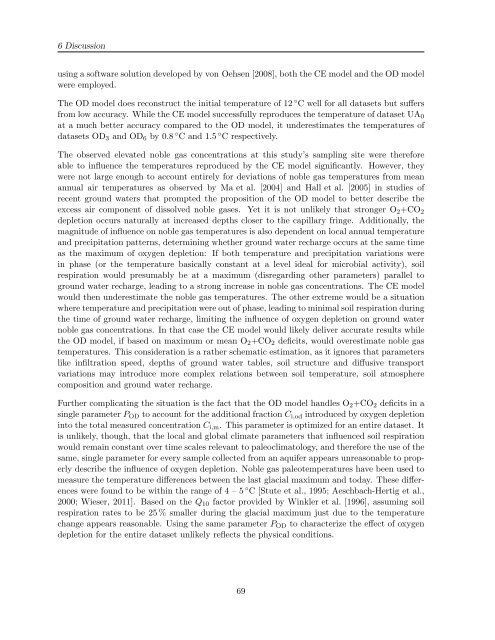Diploma thesis in Physics submitted by Florian Freundt born in ...
Diploma thesis in Physics submitted by Florian Freundt born in ...
Diploma thesis in Physics submitted by Florian Freundt born in ...
You also want an ePaper? Increase the reach of your titles
YUMPU automatically turns print PDFs into web optimized ePapers that Google loves.
6 Discussion<br />
us<strong>in</strong>g a software solution developed <strong>by</strong> von Oehsen [2008], both the CE model and the OD model<br />
were employed.<br />
The OD model does reconstruct the <strong>in</strong>itial temperature of 12 ◦ C well for all datasets but suffers<br />
from low accuracy. While the CE model successfully reproduces the temperature of dataset UA0<br />
at a much better accuracy compared to the OD model, it underestimates the temperatures of<br />
datasets OD3 and OD6 <strong>by</strong> 0.8 ◦ C and 1.5 ◦ C respectively.<br />
The observed elevated noble gas concentrations at this study’s sampl<strong>in</strong>g site were therefore<br />
able to <strong>in</strong>fluence the temperatures reproduced <strong>by</strong> the CE model significantly. However, they<br />
were not large enough to account entirely for deviations of noble gas temperatures from mean<br />
annual air temperatures as observed <strong>by</strong> Ma et al. [2004] and Hall et al. [2005] <strong>in</strong> studies of<br />
recent ground waters that prompted the proposition of the OD model to better describe the<br />
excess air component of dissolved noble gases. Yet it is not unlikely that stronger O2+CO2<br />
depletion occurs naturally at <strong>in</strong>creased depths closer to the capillary fr<strong>in</strong>ge. Additionally, the<br />
magnitude of <strong>in</strong>fluence on noble gas temperatures is also dependent on local annual temperature<br />
and precipitation patterns, determ<strong>in</strong><strong>in</strong>g whether ground water recharge occurs at the same time<br />
as the maximum of oxygen depletion: If both temperature and precipitation variations were<br />
<strong>in</strong> phase (or the temperature basically constant at a level ideal for microbial activity), soil<br />
respiration would presumably be at a maximum (disregard<strong>in</strong>g other parameters) parallel to<br />
ground water recharge, lead<strong>in</strong>g to a strong <strong>in</strong>crease <strong>in</strong> noble gas concentrations. The CE model<br />
would then underestimate the noble gas temperatures. The other extreme would be a situation<br />
where temperature and precipitation were out of phase, lead<strong>in</strong>g to m<strong>in</strong>imal soil respiration dur<strong>in</strong>g<br />
the time of ground water recharge, limit<strong>in</strong>g the <strong>in</strong>fluence of oxygen depletion on ground water<br />
noble gas concentrations. In that case the CE model would likely deliver accurate results while<br />
the OD model, if based on maximum or mean O2+CO2 deficits, would overestimate noble gas<br />
temperatures. This consideration is a rather schematic estimation, as it ignores that parameters<br />
like <strong>in</strong>filtration speed, depths of ground water tables, soil structure and diffusive transport<br />
variations may <strong>in</strong>troduce more complex relations between soil temperature, soil atmosphere<br />
composition and ground water recharge.<br />
Further complicat<strong>in</strong>g the situation is the fact that the OD model handles O2+CO2 deficits <strong>in</strong> a<br />
s<strong>in</strong>gle parameter POD to account for the additional fraction Ci,od <strong>in</strong>troduced <strong>by</strong> oxygen depletion<br />
<strong>in</strong>to the total measured concentration Ci,m. This parameter is optimized for an entire dataset. It<br />
is unlikely, though, that the local and global climate parameters that <strong>in</strong>fluenced soil respiration<br />
would rema<strong>in</strong> constant over time scales relevant to paleoclimatology, and therefore the use of the<br />
same, s<strong>in</strong>gle parameter for every sample collected from an aquifer appears unreasonable to properly<br />
describe the <strong>in</strong>fluence of oxygen depletion. Noble gas paleotemperatures have been used to<br />
measure the temperature differences between the last glacial maximum and today. These differences<br />
were found to be with<strong>in</strong> the range of 4 – 5 ◦ C [Stute et al., 1995; Aeschbach-Hertig et al.,<br />
2000; Wieser, 2011]. Based on the Q10 factor provided <strong>by</strong> W<strong>in</strong>kler et al. [1996], assum<strong>in</strong>g soil<br />
respiration rates to be 25 % smaller dur<strong>in</strong>g the glacial maximum just due to the temperature<br />
change appears reasonable. Us<strong>in</strong>g the same parameter POD to characterize the effect of oxygen<br />
depletion for the entire dataset unlikely reflects the physical conditions.<br />
69
















